I’ll fast forward to the answer and say, yes I think it’s in the same ballpark. I need to give credit for the title of this blog to a cycling friend who reminded me this week of what a famous runner once said. My friend posted a picture of himself from a long time ago finishing a marathon in 2 hours 59 minutes and some short change. He said that at the time he trained really hard to achieve this as Robert de Castella once said that the sub 3 hour marathon was the difference between a runner and a jogger. So it is that many club level cyclists have the goal of being able to achieve a functional threshold power (FTP) of 4W/kg.
Granted 4W/kg is never going to make you a pro. But nor is a sub 3 hour marathon. As we know, that’s nearly an hour (or one third) more than what it takes to be world class. And so is 4W/kg if you consider that 6W/kg on the major climbs of grand tours is about the benchmark for being in the first half of the field. However, 4W/kg is still better than most club level cyclists, and is literally lapping everyone on the couch. So it’s a great goal to target. And it is the goal that the rider in this case study wanted to achieve. The plot below is from WKO5. It is plotting the rider’s power duration curve against the WKO5 athlete database, indicating 4.3W/kg for 20 minutes is considered very good.
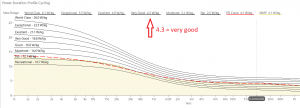
This is a case study that I am really happy to be able to share as the rider completely deserves the improvement in his FTP. It is also a good example of how a patient, consistent approach to training works. You don’t have to do a huge volume of training to get improvement in performance. You need to do an appropriate amount of your training at the appropriate intensity. And that is what this athlete did.
Background information
The athlete approached me in August of last year with a view to coaching. Said goal was to get his FTP to 4W/kg. To get a baseline we did a FTP test which was 348W on a body weight of 93kg (he is a big unit). This is 3.74W/kg. On first glance this does not look like a huge improvement is required. It’s in the vicinity of 7-8%. However you have to consider this in the context of the training background. If the rider had come to you with no or limited training background then an improvement of less than 10% is achievable quite quickly. But when the rider comes to you with a solid training background then the goal, by definition, is going to be more challenging to achieve. This athlete was riding an average of around 10 hours/week. It was largely unstructured training, but there was a reasonable amount of high intensity work in the mix courtesy of some ‘testosterone driven’ group rides.
The athlete went away for an extended family holiday for almost 2 months. During this time he did no training at all. He left for the holiday with a Chronic Training Load (CTL) of 69 and returned with a CTL of 17! Argh, we had some work to do. Here is the Performance Management Chart (PMC) from TrainingPeaks showing what we did. I’ll go into each block in a little more detail.
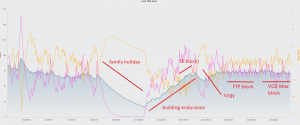
The good thing when faced with a scenario like this (losing so much training load) is that because the athlete had a reasonable training background he should bounce back quite well. Because, in general you de-train less and re-train faster when you have a solid endurance training background.
October 2019 – athlete returned from overseas ready to re-commence training. First thing to do was re-test FTP to ensure training zones and targets were set appropriately. Re-test FTP was ugly, no other words for it. Here it is. I’ve highlighted the 20 minutes of the test. Also of note, you can see the cardiac drift. That is, the drift upwards in heart rate across the test that is not matched by an increase in power. This is normal for a FTP test. We would expect to see this on a max effort. My reason for showing this is you can also see the maximum heart rate I have marked at 180. The athlete was trying. No question of that. This is where heart rate is very useful for examining intent and effort. This high heart rate is also typical of athletes returning from a training break. It becomes the limiter, rather than power being the limiter. Also of note, the athlete volunteered after the test that he still had a bit of man flu lurking about. And before you say anything, yes if I had known that I would not have programmed the test. Summary: The FTP had dropped to 296W which is 3.16W/kg.
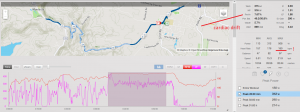
November 2019
Athlete recommenced with an endurance training block. We need to get some solid endurance kilometres in the bank without too much intensity. Over this time the main thing I was monitoring was what his heart rate was doing relative to power. I wanted to see him improve his efficiency. That is; the power would come at a lower heart rate cost. This is a metric that you can monitor through TrainingPeaks. However you also need to look at the pattern of the response. It is not just about the numbers. I was looking for how responsive the heart rate was. When you are relatively unfit heart rate tends to stay elevated for longer after small rises in terrain. As an athlete gets fitter I’m looking for a ‘springiness’ in their heart rate such that it drops back down quickly with rises and falls in terrain. During November we re-tested FTP on the same road segment and it had improved to 326W. This was 3.48W/kg, better but still not back up to his pre-holiday FTP.
December 2019
Continued with the endurance block but introduced some strength endurance work. This was predominantly in the form of seated climbing repeats. These are one of my favourite sessions for developing muscular endurance. Here is an example of what one of these sessions looks like. Pink is power and red is heart rate.

In mid-December we re-tested FTP again on the same segment and it was 350W. The rider had lost a little weight and was down to 91kg. This placed the FTP at 3.84W/kg. So we were back to where he was, or a little higher than pre-holiday. It took 8 weeks to do this. However straight after this the rider again came down with a viral illness. You can see the decrease in training load in the PMC. It is important to note that this pattern of viral illnesses was unlikely related to overall training load as this was not excessive. The goal event for the rider was the hilly Buderim 9 (75km and 1700m). He sensibly ended up not doing the event. Any sort of viral illness and high intensity training should not be included in the same sentence.
January and February 2020
We re-group after the illness and have a discussion about the way forward. For some time I had been thinking to myself that the rider’s physiology was more akin to a time triallist. He has a huge engine and I was seeing this more. Also, a larger body mass is less of an issue in time trialling, as absolute power on the flat is more important. Sure, watts/kilogram are still important; but flat time trial courses are more forgiving with regard to this. Put it this way: 300 watts on the flat from a 90kg rider (3.3W/kg) will likely beat 280 watts from an 80kg rider (3.5W/kg). We talked about this and decided to keep the goal of the 4W/kg, but with a view to developing the rider as a time triallist. The next 4 week training block we did was therefore a FTP block. This included sessions such as 2 x 20 minute and 4 x 15 minute at FTP. Here is what one looked like:

At the beginning of March we re-tested FTP again. The rider cranked out 360W. A personal best. On top of this the rider had made some changes to his eating habits and lost some weight. At 89kg this placed his FTP at exactly 4W/kg. Utopia. Goal achieved. Well maybe not utopia, that’s hyperbole. But it was pretty jolly close. Now I know you might look at that and say it is only 12W (3%) better than his pre-holiday FTP test. But, and here is the big but, he had lost weight. So to be able to increase power on a lower body weight, his actual improvement was 8%. Here is the test.
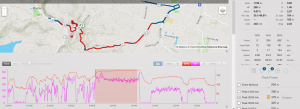
March 2020
Following the FTP block it was always my intention that the athlete would move into a VO2 max block. The rationale behind this: think of your fitness as having a ceiling (FTP) and a roof (VO2 max). We had worked on improving the ceiling to a point where returns were going to decline. We needed to raise the roof. And the way to do this was through a solid VO2 max block. This was 3 sessions a week of dedicated work. This is where I really need to give credit to the athlete. It is not easy to do this type of work. It takes a lot of discipline. They were hard sessions. I tweaked them each week based on what I was seeing in WKO5 (optimised intervals and dynamic functional reserve capacity). The athlete was completely compliant and took the challenge on board. Here’s a sample session. This is 8 x 3 minutes at 105-115% of FTP. I’ve included the laps down the bottom so you can see the actual intensity the rider achieved (1.04 to 1.09, i.e. 104-109%). I asked the rider to read this blog before I published it, and he said I should mention #8 below and the fact he miscounted and ‘died on the last one’.
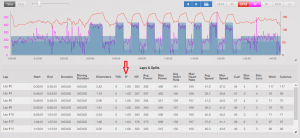
April 2020
After the 4 week VO2 max block it is time to re-rest FTP. Rider achieved a PB of 368W (best before was 360W). But he had dropped a little more weight, placing his FTP now at 4.2 W/kg. Look at the maximum heart rate – 178bpm. It is less than the maximum heart rate he had on the first test he did back from the extended holiday. Summary – there is still a little more improvement there. And for what it’s worth, there is a huge difference between the 3.7W/kg he started at and the 4.2W/kg he has achieved.
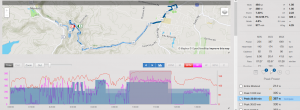
Summary
This turned out to be a much longer blog than I anticipated. But it has been well worthwhile as I think it gives you the full picture of what it takes to get improvement in performance. This rider went through some challenging periods with illness. But as soon as we could get him riding consistently, with a solid foundation then we started to get results. I know I harp on about consistency, but it really is the key. If you are consistent you will improve. If you are consistent and train appropriately, you will improve even more.
What is more impressive is that this athlete has done this in the absence of any racing goals. Yes, we had racing goals later in the season for an individual time trial series. But we didn’t know any of the details of the series as they were so far in advance. Together we set a goal that was independent of races and specific to the athlete. That’s a pretty powerful message for the current COVID times we are living in. Your goals do not have to be race based, they can be performance based. With a structured and consistent training program, focus and discipline; this athlete has achieved his goal. And from where I sit as a coach and scientist, it was an absolute treat to work with him.